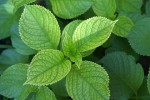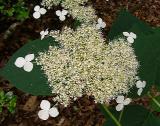Hydrangea Root
(Hydrangea arborescens)
- Alias names for Hydrangea: Wild Hydrangea, Seven Barks, Smooth Hydrangea, Radix Dichroae Dichroa febrifuga Lour, Family Hydrangeaceae, Pronounced hy-DRAIN-juh
- Chinese Names for Hydrangea: Ch¨¢ng Shan, Chang Shan
Pictures of Hydrangea:
References for Hydrangea pictures:
- https://www.pbase.com/bstelloh/wildflowers
- https://caliban.mpiz-koeln.mpg.de/~stueber/mavica/high/1500/01324.html
About Hydrangea: This woody-stemmed deciduous shrub has lacy-flowers. It is a wild shrub and a relative of beautiful large flowered blue or pink ornamental variety you see planted in yards which make nice dried flowers. The large white flowers on the edge of the flower head are sterile and are used as “attention getters” to attract pollinators to the smaller fertile flowers. Hydrangea is a fast-growing East Coast shrub growing in the woodlands and on riverbanks. They grow from 3′-10′ tall and wide. White flowers appear in late June through September on new wood. The plant can be cut to the ground in late fall or early spring.
Hydrangea plants like moist, well-drained, hummus-rich soil and live best in the sun or partial shade but where the yard is protected from early morning sun in frosty areas. Supplemental watering will be required during hot, dry summers. Remove dead flower heads and cut back previous year’s flowering shoots in the early spring.
Hydrangea root was used by the American Indian (esp. Cherokee) as a remedy for kidney and bladder stones and is currently being studied as a treatment for malaria.
‘Annabelle’ and ‘Grandiflora’ are commonly available cultivars. Propagation is best by softwood cuttings in May-June or by division in late winter or early spring. Smooth Hydrangea is hardy in zones 4-9.
Actions and Historical Uses of Hydrangea:
- Antiseptic
- Diuretic
- Encourages expulsion of stones (from diuretic effect)
- Good for rheumatoid arthritis
- Helps cystitis
- Helps gout
- Helps to dissolve existing stones (bladder, kidney and gallstones)
- Helps with inflammation of urethra and prostate (prostatitis)
- Malaria (Chinese use to treat Plasmodium falciparum)
- Reduces formation of urinary stones
- Soothes irritated tissues
How Hydrangea is used and how it Works: It can be used as a decoction, tincture, extract, and in capsule form or you can use the powdered root to make a tea infusion.
Parts of Hydrangea Plant Used: Roots are dug in the fall and dried or transplanted.
Properties of Hydrangea: A sweet, pungent herb historically used for the treatment of bladder and kidney stones.
Chemical Constituents of Hydrangea: Contains flavonoids, cyanogenic glycoside (hydrangein), saponins, quinazoline alkaloids and a volatile oil.
Contraindications, safety issues, concerns, harmful drug interactions and allergy precautions for Hydrangea: Too much can cause dizziness and bronchial congestion.
Other Notes for Hydrangea: Other herbs used with Hydrangea include Aphanes arvensis (field parsley piert), Eupatorium purpureum (also called Joe-pye Weed, Queen of the Meadow, Gravel Root or Purple Boneset) and Arctostaphylos uva-ursi (kinnikinnick ). Native Americans mixed Hydrangea with Agropyron repens (Couch grass) and Ahhaea rosea (Hollyhock) for serious kidney disorders including nephritis.
Helpful Links and References for Hydrangea:
- Used in malaria treatment: https://www.mdidea.com/products/proper/proper080research.html
These products are not drugs, but foods for special dietary use pursuant to applicable Federal law. No statement in this page shall be construed as offering these products for the diagnosis, cure, mitigation, treatment, or prevention of any disease.
Related Pages on this website:
- Alternative Treatments for Stones
- Drugs Causing Stones & Crystals
- Gout
- High Oxalate Food List
- How to make a decoction
- How to make a poultice
- How to make a tincture
- How to make infused oils
- How to make infusions
- Hydrangea Root
- Kidney, Bladder & Gall Stones
- List of Herbs we carry
- Medical Treatment of Stones
- My Favorite Herbal Books
- My Favorite Products
- Species & Breed Predilection to Stones
- Urinalysis-What is it? What do they see?

